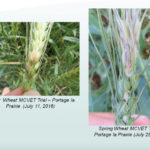
Tag Archives Fusarium ear blight

Wheat streak mosaic virus found in spring wheat, fusarium maps available
Manitoba Insect & Disease Update for June 7

New CWRS wheat coming with less DON when hit by fusarium head blight
BW980 almost didn’t make it because in one year of testing, its gluten strength was lower than the check variety, prompting another year of testing

Seed quality highly variable
A tough growing year has translated into seed that can have lower germ levels

Wheat Commission asks CGC for changes to wheat grading
The AWC says instrument-measured falling number and DON levels should replace visual proxies based on sprouting and fusarium-damaged kernels, respectively

Manitoba’s insured acres of CPS wheat grow exponentially
SeCan’s new AAC Penhold accounted for 99 per cent of the increase

Low levels of fusarium head blight are being observed in some crops
Manitoba Agriculture cereals specialist Pam de Rocquigny has some management tips
Manitoba Crop Report and Crop Weather report: No. 13
Conditions as of July 25, 2016

Early, frequent fungicide applications can be a waste
AAFC cereal pathologist Myriam Fernandez says it can also encourage more kernel diseases such as black point

Fusarium head blight no longer just a Manitoba problem
Producers across the Prairies need to manage to minimize their risk of fusarium

Soviet tractor sales and plugged grain terminals
Our History: September 1985


